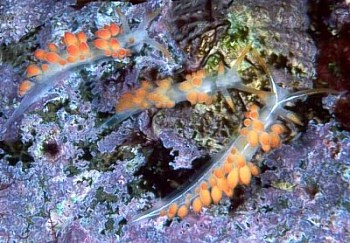
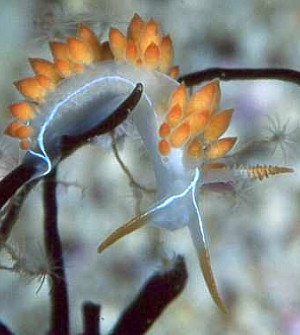
Flabellina trilineata
(O'Donoghue, 1921)
Order: NUDIBRANCHIA
Suborder: AEOLIDINA
Family: Flabellinidae
DISTRIBUTION
Baja California, Mexico to Alaska (Behrens, 1991).
PHOTO
Juveniles (10-12mm long)feeding on hydroids at Isthmus Reef, Catalina Island, California, USA. Photos: Bruce Wight.
Flabellina trilineata is a seasonally abundant aeolid ranging from Baja California, Mexico to Alaska (Behrens, 1991). It feeds on hydroid polyps, especially those of Tubularia spp. and Eudendrium californicum. Grows to about 35mm.
Distinguished by, and gets its name from, the three white lines down its body. The median line divides on the head to send a branch along each oral tentacle. However Bruce Wight's photos here suggest that sometimes the white lines are absent.
See Bruce Wight's message on colour variation and eggs.
See Jeff Goddard's message on general biology, amphipod crustacean mimic, references.
See Bruce Wight's message on juvenile & adult form.
Reference:
• O'Donaghue, C.H. (1921). Nudibranchiate mollusca from the Vancouver Island region. Transactions of the Royal Canadian Institute, Toronto, 13(1): 147-209
Rudman, W.B., 2000 (June 22) Flabellina trilineata (O'Donoghue, 1921). [In] Sea Slug Forum. Australian Museum, Sydney. Available from http://www.seaslugforum.net/find/flabtril
Related messages
Growth on Flabellina trilineata from California
May 8, 2009
From: John Yasaki
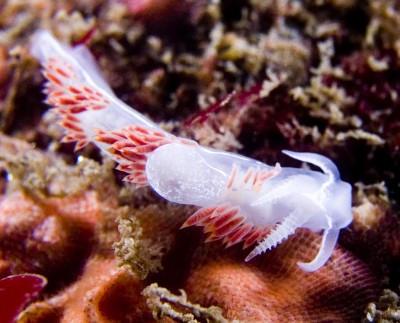
Concerning message #17085:
Found this Flabellina trilineata in Carmel, California on a boat dive at Outer Butterfly House.
While it's not an unusual critter in these parts, note the bulge on the dorsum, and the lack of pigmentation on the rhinophores and oral tentacles.
Locality: Carmel, 60 feet, California, USA, Carmel Bay, Pacific Ocean, 25 Apr 2009, Rock wall. Length: approx 20 mm. Photographer: John Yasaki.
John Yasaki
jyasaki@chabotcollege.edu
Yasaki, J. K., 2009 (May 8) Growth on Flabellina trilineata from California. [Message in] Sea Slug Forum. Australian Museum, Sydney. Available from http://www.seaslugforum.net/find/22444Dear John,
The swelling is where the pericardial sac is situated, and as its name suggests it is where the heart is found. In most aeolids it forms a raised hump, but it does seem excessively large in this animal. However after looking at the other photos of this species on the Forum there are a couple of messages [#10648, #14450] with photos of animals with similar large pericardial 'humps'. Why they appear to be abnormally large I can't say
Best wishes,
Bill Rudman
Re: Flabellina trilineata from California
August 5, 2006
From: Clinton Bauder
Concerning message #17024:
Hi Dave,
I'm a bit confused. Flabellina trilineata has annulate rhinophores whereas the rhinophores on Aidan's animal appear to be perfoliate. I'm not really sure what this critter is but I don't think it's F. trilineata. Maybe Aeolidiella oliviae?
Clinton
gecko1@apple.com
Bauder, C., 2006 (Aug 5) Re: Flabellina trilineata from California. [Message in] Sea Slug Forum. Australian Museum, Sydney. Available from http://www.seaslugforum.net/find/17085Hi Clinton,
Point well taken, Flabellina trilineata does have annulate rhinophores. The problem in attemping to make any identification from this photo is that none of the important characteristics are really clearly visible. The rhinophores are out of focus, and could definitely be annulate, although at the angle we see them I called them perfoliate. My error.
Aiden says it had white lines on the body. Nether Aeolidiella oliviae or Austraeolis stearnsi have this. Gotta stick with F. trilineata.
Thanks for the correction,
Dave Behrens
Flabellina trilineata from California
July 6, 2006
From: Aidan Hampson
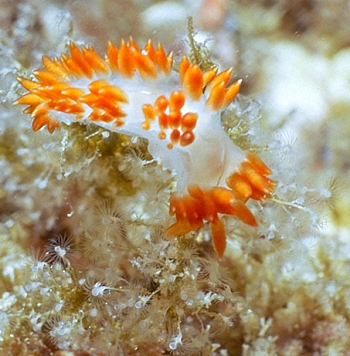
Hi,
Can anyone help me ID this species I saw this weekend. I wish I'd shot more so I could be more help. I think it is Facelina stearnsi. The bryozoans on which it was feeding are clear. The size is about 1", at least 1 central white line was present, maybe three but I can't be certain. It was on a vertical pinnacle at ~40ft. Four individuals were seen within 6 ft radius, but no others seen on 2 other dives on that reef structure. Two of the four individuals were 1", 2 only 0.5" In the same area, several orange bulls-eye ring egg masses were observed (2" diameter) with the same orange pigment as the cerrata on the individual. The pinnacle was unusual in that it was much steeper (a wall) than other rock structures in the reef
Locality: Eagle Reef, deep water (east) side Santa Catalina Island, 40-50ft, CA USA, Pacific, 24 June 2006, Wall of pinnacle 15 ft tall, at edge of reef, kelp forest. Length: 1". Photographer: Aidan Hampson.
Aidan Hampson
seaspyder@cox.net
Hampson A.J., 2006 (Jul 6) Flabellina trilineata from California. [Message in] Sea Slug Forum. Australian Museum, Sydney. Available from http://www.seaslugforum.net/find/17024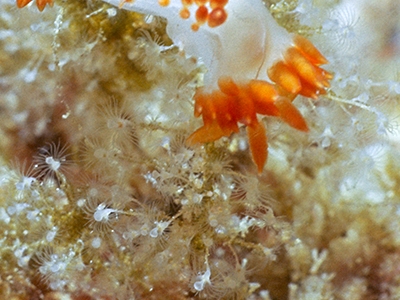
Dear Aidan,
After some hard thought I believe your critter is Flabellina trilineata. I base this identification on the color of the ceratal cores and the fact that it has perfoliate rhinophores ( and your mention of possibly three white lines). The coloration of Facelina stearnsi is quite different.
Additionally, it is feeding on tubulariid hydroids, not bryozoans. While hydroid polyps might be confused with the zooids of bryozoans, the ones in your photo have long stalks. I am unaware of any aeolid that feeds on bryozoans. Bryozoans are eaten only by a few dorids and arminaceans.
Best wishes,
Dave Behrens
Flabellina trilineata feeding
August 1, 2005
From: James Lyle
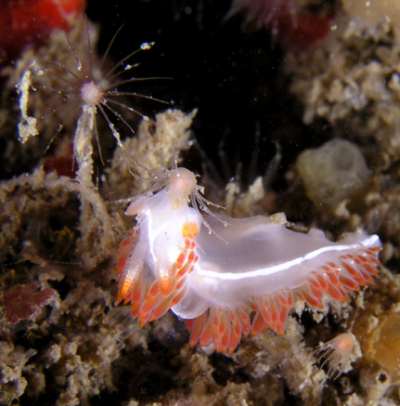
Dr. Rudman,
We are all interested in what our friends the nudibranchs eat, if only to have a better idea of where to find them. Here a a couple of pictures of Flabellina trilineata caught in the act of consuming hydroid tentacles. There are three similar species here in southern California. - Tubularia, Ectopleura, and Hybocodon. My local cnidarian expert refuses to make an identification in the absence of a collected specimen.
Locality: Rancho Palos Verdes - Buchannan's Reef, California, USA. Depth: 17 metres. Length: 10 cm. 24 July 2005. rocky reef. Photographer: Jim Lyle
Best,
Jim
jlyle@scubadiving.com
Lyle, J.L., 2005 (Aug 1) Flabellina trilineata feeding. [Message in] Sea Slug Forum. Australian Museum, Sydney. Available from http://www.seaslugforum.net/find/14450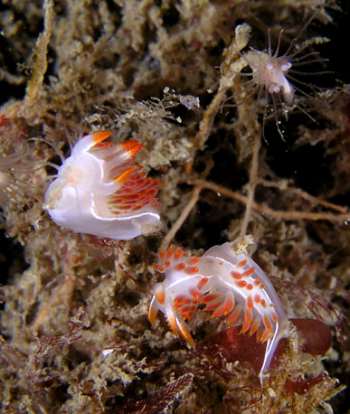
Thanks Jim,
It's always disappointing when the experts refuse to commit! I guess that's how people feel when I refuse to identify a yellow dorid, or for that matter a yellow Berthellina, just from a photo.
Best wishes,
Bill Rudman
Flabellina trilineata? from California
June 3, 2005
From: Denise Weisman
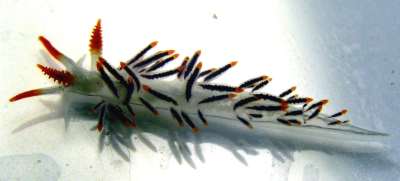
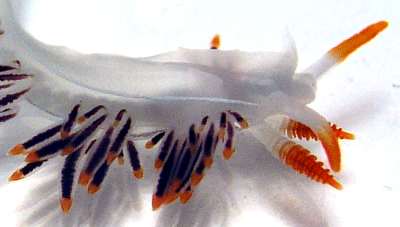
Hello,
A co-worker collected and photographed this nudibranch from the San Clemente Artificial Reef, California. From the annulate rhinophores (and faintly visible white dorsal line) we are guessing Flabellina trilineata and that the dark cores of the cerata and lack of white tips are either just a color variation or possibly Cuthona lagunae.
Locality: San Clemente Artificial Reef, California, USA. Depth: 50 feet. Length: ~3 cm. 07 November 2003. Subtidal quarry rock. Photographer: Danielle Toole
The white lines look black in the upper photo. This is some strange affect of photographing it on a white background. They were definitely white.
Thanks for you help,
Denise Weisman
weisman@lifesci.ucsb.edu
Weisman, D, 2005 (Jun 3) Flabellina trilineata? from California. [Message in] Sea Slug Forum. Australian Museum, Sydney. Available from http://www.seaslugforum.net/find/13904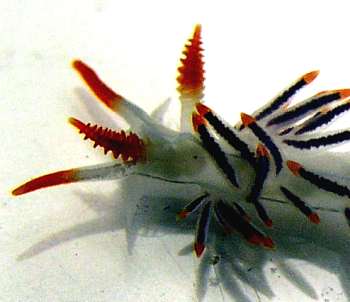
Dear Denise,
This seems to be F. trilineata although as you say the ceratal digestive gland is usually described as ranging from from red to orange. I haven't heard of one with a black digestive gland. This colour form certainly looks superficially like Cuthona lagunae but that species does not have the three white lines, nor tentacular anterior foot corners, nor lamellate rhinophores.
Best wishes,
Bill Rudman
Flabellina trilineata juveniles
March 23, 2004
From: Sean Kearney
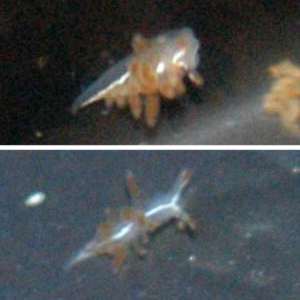
Dear Bill
Following my last message [#12493 ], here are photos of the Cuthona?. They were also found in 65fsw off of Pt. Loma, San Diego, California. [March 2004].
It is a mystery to me. I studied the small one (1 to 1.5mm) under a scope and made a few notes: the rhinophores appeared plain and well separated, about the same length as the oral tentacles. A white encrustation occurred on the oral tentacles forming a line down the center of the dorsum just short of the tip of the tail. A white encrustation occurred on both sides just past the first group of cerata extending to the tip of the tail. The three lines very similar to Flabellina trilineata. The sausage shaped cerata had light brown cores and were grouped on opposite sides at the dorsal margin. The first group seemed to have four to five cerata (left side) second group four, third group two, fourth group two, and the fifth was a single. The cerata on the right side were just slightly offset to the anterior end of the group opposite on the left side. On each group the largest ceras was toward the rear of the group. The eyes were midway between the rhinophores and the first group of cerata. The head was rounded and cleft from a front view and the foot did not seem to have much of a margin beyond the width of the animal. It too was indented in the middle (from front view). Body was translucent grey. Fast moving for such a little guy.
Thanks,
Sean Kearney
skearney@dc.rr.com
Kearney, S., 2004 (Mar 23) Flabellina trilineata juveniles. [Message in] Sea Slug Forum. Australian Museum, Sydney. Available from http://www.seaslugforum.net/find/12494Dear Sean.
It seems to me that these are Flabellina trilineata. They differ in not having lamellae on the rhinophores or any sign of extensions to the front foot corners, but both these features only appear as the animal grows. Since the one you studied was 1 - 1.5 mm long, it clearly has a lot of growing to do.
Best wishes
Bill Rudman
Flabellina trilineata laying eggs
August 4, 2003
From: Bruce Wight
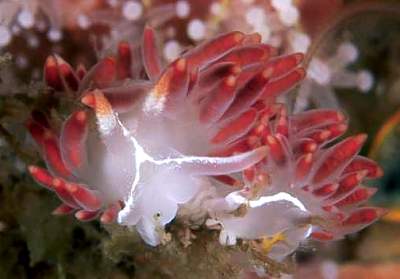
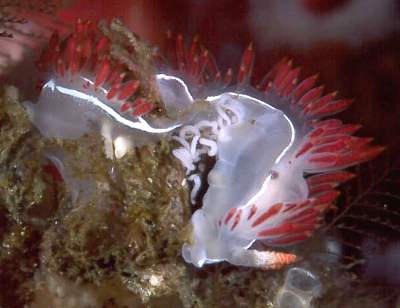
Dear Bill,
Johanna and I saw lots of great natural behavior on last weekends dive trip out to San Miguel Island [Channel Islands National Park, California - July 2003]. Here is one of a series of messages showing some images I took during the two day trip.
These photos are of Flabellina trilineata laying eggs. They were hard to photograph swaying in the surge.
Hope you enjoy the images,
Bruce Wight
bwproductions@earthlink.net
Wight, B., 2003 (Aug 4) Flabellina trilineata laying eggs. [Message in] Sea Slug Forum. Australian Museum, Sydney. Available from http://www.seaslugforum.net/find/10648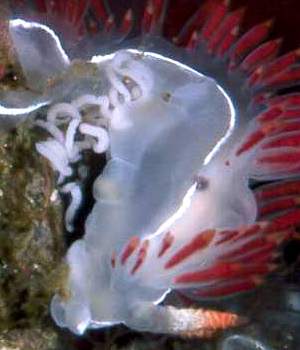
Thanks Bruce,
Bill Rudman
Flabellina trilineata from British Columbia
January 21, 2003
From: Clinton Bauder
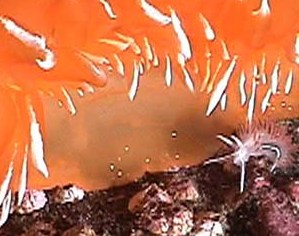
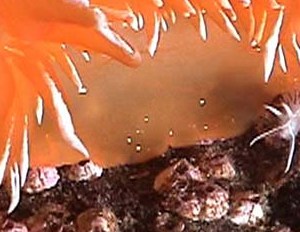
Hi Bill,
Looking at the photos I sent you of Dirona aurantia, I realized I gave you a two-fer! If you look closely at the upper image you'll see along the left flank of the big Dirona a small aeolid. I'm pretty sure it's Flabellina trilineata. I'm basing this on the white lines down the sides and the fact that they form a Y on the head (most clearly seen in lower image file I've enclosed). Aside from nearly being run over it seemed oblivious to the larger animal which likewise ignored the smaller one.
Data: Mayne Is., British Columbia, Canada. 20m depth.
Clinton
gecko1@apple.com
Bauder, C., 2003 (Jan 21) Flabellina trilineata from British Columbia. [Message in] Sea Slug Forum. Australian Museum, Sydney. Available from http://www.seaslugforum.net/find/8932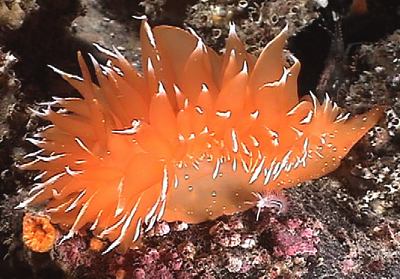
Thanks Clinton,
When I look at your original photo [copy alongside] I'm surprised I missed it - it seems so obvious now you pointed it out. I hope it doesn't indicate how much we probably miss in the field. I think your identification is correct, you can also see the white line on the side of the body.
Cheers,
Bill Rudman
Flabellina trilineata from San Miguel, Calif.
August 12, 2002
From: Bruce Wight
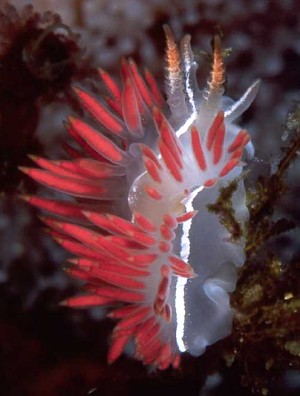
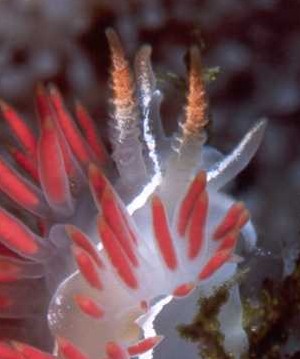
Dear Bill,
Here is a photo of Flabellina trilineata from out recent trip to San Miguel Island, California [July, 2002].
Thanks,
Bruce Wight
bwproductions@earthlink.net
Wight. B., 2002 (Aug 12) Flabellina trilineata from San Miguel, Calif.. [Message in] Sea Slug Forum. Australian Museum, Sydney. Available from http://www.seaslugforum.net/find/7708Thanks Bruce,
You can clearly two of the three white lines which give this species its name
Bill Rudman
Flabellina trilineata from Canada
December 19, 2000
From: Marli Wakeling
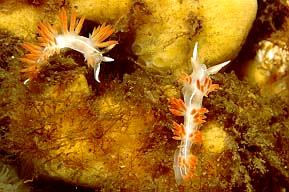
Hi Bill,
Here is a Flabellina trilineata from British Columbia, Canada. It is very common on Vancouver Island. This is a fairly small animal, 1 to 2 cm. usually.
Marli
scubamarli@excite.com
Wakeling, M., 2000 (Dec 19) Flabellina trilineata from Canada. [Message in] Sea Slug Forum. Australian Museum, Sydney. Available from http://www.seaslugforum.net/find/3313Thanks Marli,
It's nice to see some photos of the Canadian Pacific coast fauna.
Bill Rudman.
Re: Flabellina trilineata rhinophores
June 30, 2000
From: Bruce Wight


Hi Doc,
Here are a couple more examples of juvenile Flabellina trilineata without any white markings. Slide #005503 was taken at Isthmus reef, Catalina Island, California on November 26, 1999, slide #003649 was taken at San Clemente Island, California on September 13 1996.
Hope this will provide you with enough juveniles with lamellate rhinophores. Sorry it took so long to get back to you, but we were out photographing branchs and other great marine life all weekend, out at our local Southern California Islands.
Have a great week,
Bruce Wight
bwproductions@earthlink.net
Wight, B., 2000 (Jun 30) Re: Flabellina trilineata rhinophores. [Message in] Sea Slug Forum. Australian Museum, Sydney. Available from http://www.seaslugforum.net/find/2637Dear Bruce,
Thanks for the photos clearly showing the lamellate rhinophores. The Flabellina trilineata page has been the fastest growing page on the Forum! I have only used two of your four photos, one with orange, and one with brown cerata.
You have made an interesting find.
Best wishes,
Bill Rudman.
Re: Flabellina trilineata
June 27, 2000
From: Bruce Wight
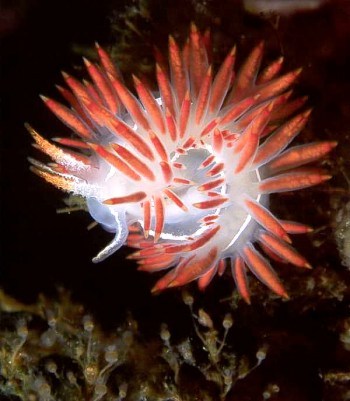
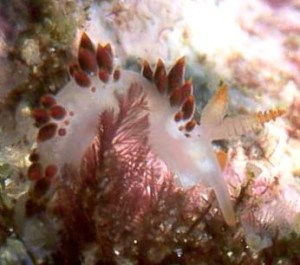
Hi again Doc.
To answer your question about the size of the animals in the photos is between 3/8" and 1/2" [10-12mm]. They are all juveniles, which are characterized in this species by the underdeveloped bulbous cerata and small size. The UPPER photo is an adult which has longer more elegant looking cerata. I often times see the juveniles without the white striping, but I have never seen an adult without it. That mimic crustacean on your site is incredible, are they seen down in Southern California or just farther north?
Hope you enjoy the images,
take care
Bruce Wight
bwproductions@earthlink.net
Wight, B., 2000 (Jun 27) Re: Flabellina trilineata. [Message in] Sea Slug Forum. Australian Museum, Sydney. Available from http://www.seaslugforum.net/find/2628Dear Bruce,
Thanks for the great photos of the adult and unlined juvenile, which clearly has lamellate rhinophores. From Jeff Goddard's message it seems his crustacean mimic is in Oregon but there is another colour form which mimics Flabellina iodinea in central California.
I will post your photos of Ancula and Hopkinsia as separate messages.
Best wishes,
Bill Rudman.
More observations on Flabellina trilineata
June 26, 2000
From: Jeff Goddard
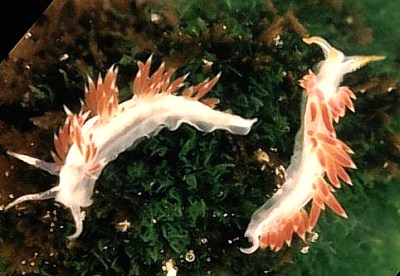
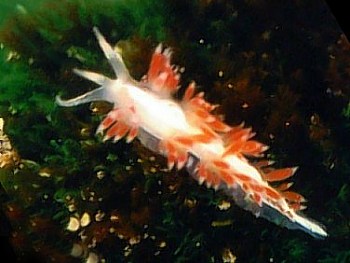
Hi Bill,
Bruce Wight may indeed have found a new color form of Flabellina trilineata. I have checked a bunch of references (including O'Donoghue's papers and original description of F. trilineata, Marcus (1961), MacFarland (1966), McDonald & Nybakken (1980), McDonald (1983), Behrens (1991), the papers of Jim Lance and Joan Steinberg, and most of the annotated species lists from the northeastern Pacific) and can not find any mention of individuals of this species lacking white lines. The lines are sometimes faint, but I have never seen F. trilineata without them. Most of my work, however, has been in the intertidal from central California to Washington. Perhaps we can get some feedback on this color form from other workers in the region (I will pass this message along to Terry Gosliner, Dave and Mike Behrens, Hans Bertsch, Gary McDonald and Sandra Millen).
The unlined specimens in Bruce Wight's beautiful photos do look like Flabellina trilineata to me, especially in the length and taper of the rhinophores and cephalic tentacles, and the fusiform shape of the cerata. However, to be certain about their identity, we need to know if the rhinophores are annulate or smooth. If the latter, then those specimens could be Catriona rickettsi Behrens, 1984, which can look much like unlined F. trilineata. I have found both species in abundance together on the same patches of the hydroid Tubularia sp. on the south jetty of the Umpqua River, Oregon.
Since we are on the subject of lookalikes of Flabellina trilineata, here are two photos of F. bertschi Gosliner & Kuzirian, 1990. In the UPPER photo the aeolid on the right is F. trilineata [note the lamellate rhinophores]. I found these aeolids together in a mid intertidal pool at Punta San Andrés (28o 42.50' N, 114o 18.07' W) on the west coast of Baja California just this past March. At first glance I thought I was seeing 14 specimens of F. trilineata. Closer inspection, however, revealed two of the 14 to have a broad white swath on the notum and smooth rhinophores, instead of the three white lines and annulate rhinophores of F. trilineata.
Best wishes,
Jeff
goddard@lifesci.ucsb.edu
Goddard, J., 2000 (Jun 26) More observations on Flabellina trilineata. [Message in] Sea Slug Forum. Australian Museum, Sydney. Available from http://www.seaslugforum.net/find/2619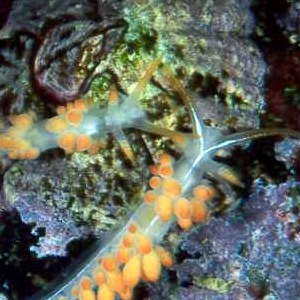
Dear Jeff,
Here is a closeup of part of Bruce Wight's photo. It seems to show that the rhinophores in the unlined form are lamellated as in 'typical' animals, but I will ask Bruce if he has a clearer photo of the rhinophores.
Best wishes,
Bill Rudman.
Flabellina trilineata and its amphipod crustacean mimic
June 23, 2000
From: Jeff Goddard
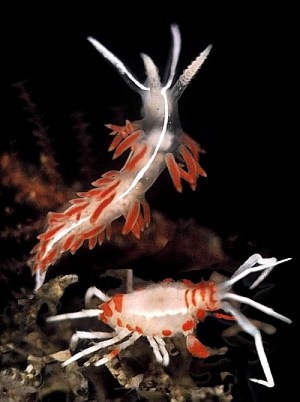
Hi Bill,
Here is a photo I took in the lab in 1984 of a 10 mm long Flabellina trilineata and its amphipod crustacean mimic, Podocerus cristatus (Thompson, 1879), from Cape Arago, Oregon, USA. I have also enclosed a brief account of the biology and range of the aeolid.
Flabellina trilineata is a seasonally abundant aeolid ranging from Baja California, Mexico to Alaska (Behrens, 1991). It feeds on hydroid polyps, especially those of Tubularia spp. and Eudendrium californicum (McDonald & Nybakken, 1978; Goddard, 1984). Flabellina trilineata always have white pigment on their rhinophores and cephalic tentacles, but one color form has distally on these appendages an additional, overlying red orange pigment. Both color forms consistently have three white stripes running the length of the body.
The color form of the amphipod mimic shown here has only been collected from the southern Oregon coast, often under the same overhangs and cobbles as its aeolid model (Goddard, 1984b, unpublished observations). Most amphipods are edible to fish, and this mimicry is likely an example of Batesian mimicry, in which an edible organism gains protection from its predators by mimicking an inedible or repugnant organism.
A purple and orange colored form of Podocerus cristatus occurs in central California (Gosliner & Behrens, 1990), where the stunningly purple and orange colored aeolid, Flabellina iodinea (Cooper, 1862) is often one of the most abundant and conspicuous nudibranchs.
References:
• Behrens, D.W. 1991. Pacific coast nudibranchs. Sea Challengers: Monterey, California.
• Goddard, J.H.R. 1984. The opisthobranchs of Cape Arago, Oregon, with notes on their biology and a summary of benthic opisthobranchs known from Oregon. The Veliger, 27(2): 143-163.
• Goddard, J. 1984b. Presumptive Batesian mimicry of an aeolid nudibranch by an amphipod crustacean. Shells and Sea Life [previously and subsequently the Opisthobranch Newsletter] 16: 220-222.
• Gosliner, T. M. & D. W. Behrens. 1990. Special resemblance, aposematic coloration and mimicry in opisthobranch gastropods. Pp. 127-138 in, M. Wicksten (ed.), Adaptive coloration in invertebrates. Texas A&M University Sea Grant Program: College Station, Texas, USA.
• McDonald, G.R. & J.W. Nybakken. 1978. Additional notes on the food of some California nudibranchs with a summary of known food habits of California species. The Veliger, 21(1): 110-119.
Best wishes,
Jeff Goddard
goddard@lifesci.ucsb.edu
Goddard, J.H.R., 2000 (Jun 23) Flabellina trilineata and its amphipod crustacean mimic. [Message in] Sea Slug Forum. Australian Museum, Sydney. Available from http://www.seaslugforum.net/find/2608Dear Jeff,
Thanks for the photos. It's quite a coincidence to have both your message and Bruce Wight's at the same time. It certainly is an amazingly coloured amphipod.
I would be interested in your comments on Bruce Wight's photo of animals without white lines. Unless there is an amazing Flabellina mimic it looks like this species does not always have white lines.
Best wishes,
Bill Rudman.
Observations on Flabellina trilineata
June 23, 2000
From: Bruce Wight
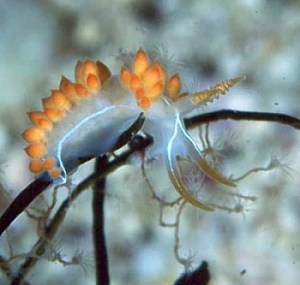
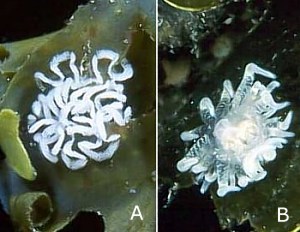
Great to hear back from you Doc. I hope we can serve as valuable resources to each other in the future. I will look through my files to see if we have any photos of Ancula feeding.
Here is an interesting one for you. Last year my wife and I were photographing juvenile Flabellina trilineata nudibranchs feeding on
hydroids at Isthmus Reef at Catalina Island. They were all over and some did not have the distinctive white striping. The real interesting part came when we got our images back from the lab. In addition to the small nudibranchs we photographed, my wife Johanna and I were also photographing small white clumps on the on the algae. When we looked at the photos through a loupe we noticed her photos were of a F. trilineata eggs mass and my photos were of a small white anemone. They were both very numerous, 1/4" or so in diameter and on the same clumps of algae, in the same area on the reef. Is the anemone trying to mimic the eggs, which may be foul tasting, or are the eggs mimicking the small anemone armed with its nematocysts?
Talked to both Dave Behrens and Mike Miller about it, neither had ever heard of such a thing. What do you think?
Bruce Wight
bwproductions@earthlink.net
Wight, B., 2000 (Jun 23) Observations on Flabellina trilineata. [Message in] Sea Slug Forum. Australian Museum, Sydney. Available from http://www.seaslugforum.net/find/2609Dear Bruce,
Thanks for the photos and your observations. I have put some of your photos at the top of the page. Can you give us some idea of the size of your animals? I am not familiar with this species but I think your photos of animals without the white lines will be of great interest to local experts.
To your question about possible egg-anemone mimicry. Proving that two spectacularly similar organisms are mimics is very difficult. We have quite a few examples of potential mimicry in the Forum, but our chances of actually proving that some of these species have evolved to look alike in shape and colour are very slim. What I can say is that the egg mass shape is a common shape for many aeolids, and similar little whitish anemones are found on brown algae in many parts of the world so its unlikely that the similarity beween the two is a case of mimicry. Mimicry in nature has a special meaning. It doesn't just mean that two or more species look alike. It means they look alike because through evolution one has gradually become more alike the other, or both have become more alike each other. Have a look at my answer to Christine's message for a fuller explanation on mimicry.
Thanks again for sharing your finds with us all,
Best wishes,
Bill Rudman.
